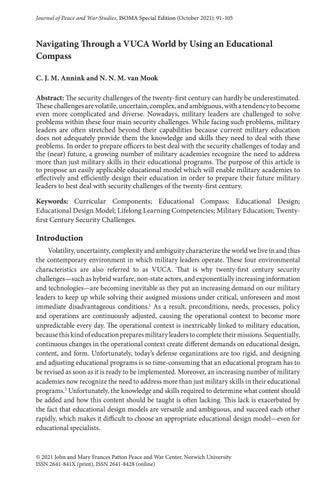Journal of Peace and War Studies, ISOMA Special Edition (October 2021): 91–105
Navigating Through a VUCA World by Using an Educational Compass C. J. M. Annink and N. N. M. van Mook Abstract: The security challenges of the twenty-first century can hardly be underestimated. These challenges are volatile, uncertain, complex, and ambiguous, with a tendency to become even more complicated and diverse. Nowadays, military leaders are challenged to solve problems within these four main security challenges. While facing such problems, military leaders are often stretched beyond their capabilities because current military education does not adequately provide them the knowledge and skills they need to deal with these problems. In order to prepare officers to best deal with the security challenges of today and the (near) future, a growing number of military academies recognize the need to address more than just military skills in their educational programs. The purpose of this article is to propose an easily applicable educational model which will enable military academies to effectively and efficiently design their education in order to prepare their future military leaders to best deal with security challenges of the twenty-first century. Keywords: Curricular Components; Educational Compass; Educational Design; Educational Design Model; Lifelong Learning Competencies; Military Education; Twentyfirst Century Security Challenges.
Introduction Volatility, uncertainty, complexity and ambiguity characterize the world we live in and thus the contemporary environment in which military leaders operate. These four environmental characteristics are also referred to as VUCA. That is why twenty-first century security challenges—such as hybrid warfare, non-state actors, and exponentially increasing information and technologies—are becoming inevitable as they put an increasing demand on our military leaders to keep up while solving their assigned missions under critical, unforeseen and most immediate disadvantageous conditions.1 As a result, preconditions, needs, processes, policy and operations are continuously adjusted, causing the operational context to become more unpredictable every day. The operational context is inextricably linked to military education, because this kind of education prepares military leaders to complete their missions. Sequentially, continuous changes in the operational context create different demands on educational design, content, and form. Unfortunately, today’s defense organizations are too rigid, and designing and adjusting educational programs is so time-consuming that an educational program has to be revised as soon as it is ready to be implemented. Moreover, an increasing number of military academies now recognize the need to address more than just military skills in their educational programs.2 Unfortunately, the knowledge and skills required to determine what content should be added and how this content should be taught is often lacking. This lack is exacerbated by the fact that educational design models are versatile and ambiguous, and succeed each other rapidly, which makes it difficult to choose an appropriate educational design model—even for educational specialists.
© 2021 John and Mary Frances Patton Peace and War Center, Norwich University ISSN 2641-841X (print), ISSN 2641-8428 (online)











